Turtles in California – 9 Species That are Found Here
California, the Golden state, is home to 9 species of turtles. Some of these species are native to this state while other are non-native. The latter found themselves there as a result of inhabitants of this state releasing their pet turtles into the ponds, and lakes in city parks.
The state also boasts as home to 5 different sea turtle species—namely leatherback, loggerhead, hawksbill, green sea, and olive ridley turtles.
Not to forget, desert tortoise species also inhabit this state.
In the following post, we take a closer look at each of these 9 turtle species. We’ll look at basic information about each of them including physical appearance, average adult size, what they eat, where they live, lifespan, and conservation status.
9 Types Of Turtles in California
Contents
1. Common Snapping Turtle
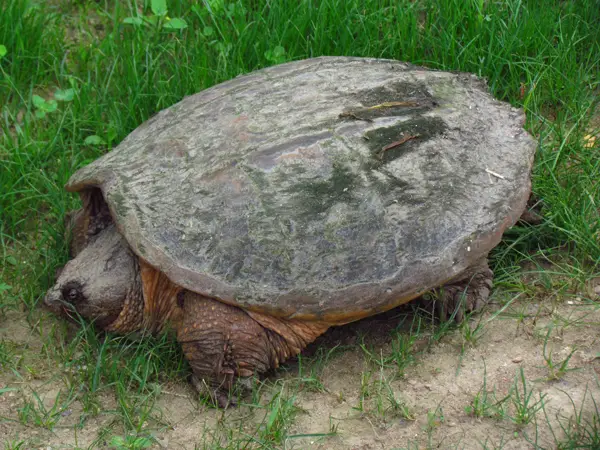
- Scientific name: Chelydra serpentina
- Common name: Snapping Turtle
- Family: Chelydridae
- Size: 8 to 18 1/2 inches
- Lifespan: 30 to 50 years or more
- Conservation status: Least Concern
Common snapping turtles are widespread throughout California. An average adult is pretty large and has a shell length of 18½ inches long.
This species has a chunky head, a long tail, and large webbed feet. The shell color is black or olive and has no distinct pattern. These California snapping turtles are known for their powerful jaws—they’re so strong that these turtles eat other turtles!
You’ll find them in waterbodies with muddy bottoms. Examples include marshes, ponds, lakes, rivers, and even shallow streams. They generally prefer waters with aquatic vegetation in plenty and foods such as fish, frogs, birds, etc.
These California turtles generally show docile behavior but can get quite aggressive if taken out of water. The best way to calm it is to take it back to the waters, where it feels safe.
2. Western Pond Turtle
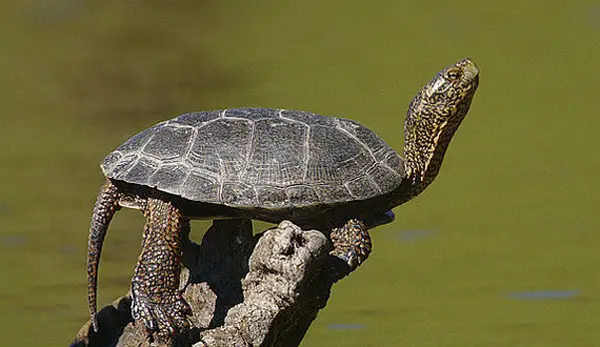
- Scientific name: Actinemys marmorata
- Common name: Western Pond Turtle, Pacific Pond Turtle
- Family: Emydidae
- Size: 6 to 8 inches
- Lifespan: 50 years
- Conservation status: Vulnerable
The Western Pond Turtle is a small-to-medium-sized turtle native to Northern Baja California.
Mind you, it is the only freshwater turtle species native to California. It can be found in the State’s creeks, ponds, lakes, and other suitable water bodies.
Carapace coloring for this turtle can be black, brown, or dark green, with some yellowish spots. Patterns of lines or dots also usually radiate from the center of each shell plate of this tortoise.
Also, the limbs of a western pond turtle found in California feature prominent scales while its head is webbed or spotted with black.
Western pond turtle species is omnivorous and its diet includes insects, tadpoles, frogs, and even carrion. For this reason, it prefers living in waterbodies with plenty of aquatic vegetation such as cattails, water lilies, watercress, etc.
The California western pond turtle has suffered habitat loss due to development, low reproduction, predators, and invasive aggressive non-native pet turtles being released into their environment.
All these factors make the species population in California state greatly endangered.
3. Texas Spiny Softshell
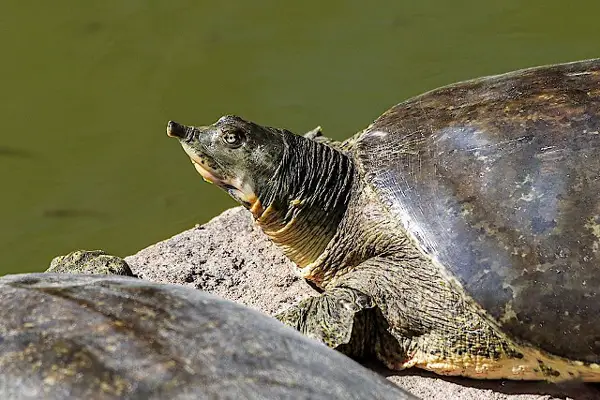
- Scientific name: Apalone spinifera emoryi
- Common name: Spiny Softshell Turtle
- Family: Trionychidae
- Size: 5 to 9 inches (males), 12 to 20 inches (females)
- Lifespan: 30 to 70 years
- Conservation status: Least Concern
The Texas Spiny softshell turtle is a medium-to-large freshwater species that live in California’s lakes, streams, and rivers with muddy or sandy bottoms and little or no vegetation.
Female spiny softshell turtles are usually larger than males. And unlike other turtles, this species has a flexible, leather-like carapace that’s extremely rounded and flattened.
The shell color can be olive grey or yellow-brown. Just like other softshell turtles, this species also has a snorkel-like snout.
The young ones feature well-defined round spots that are easily visible on the shell (though these spots become invisible as they transition to adulthood).
Spiny softshell turtles in California tend to eat anything they find in the waters including crayfish, insects, small fish, and so on. They hunt by burying themselves in the mud or sand while keeping their head uncovered to grab food as it swims by.
These turtles are also able to breathe underwater by taking in oxygen through their throat skin. This is a useful adaptation given that they don’t spend a lot of time out of water.
Other adaptations of these California turtles include webbed feed, long claws, and extremely flat shells that enable them to quickly swim away from predators and burry in the muddy bottom of the waters they reside in.
4. Painted Turtle
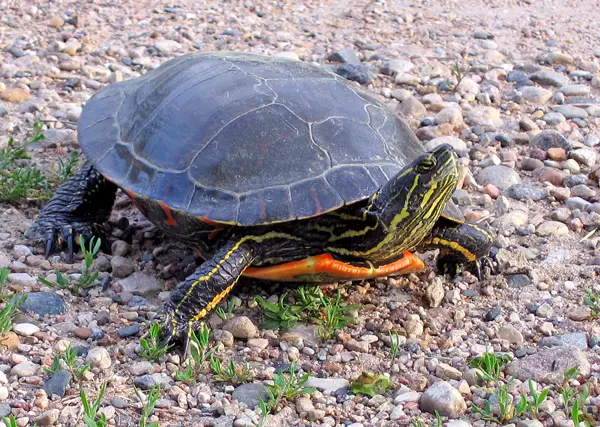
- Scientific name: Chrysemys picta
- Common name: Painted Turtle
- Family: Emydidae
- Size: 4 to 6 inches
- Lifespan: 30 to 50 years
- Conservation status: Least Concern
The painted turtle is one of the most recognizable turtle species in California, thanks to its beautiful and unique coloring. The bright reds and yellow-green markings on its shell, head, and limbs are no doubt a beauty to behold!
Note that this species has up to 4 subspecies (Eastern, Western, Midland, and Southern species). And although they may slightly differ in appearance, they all have similar behavior.
The painted turtle species in California have been observed to live near water bodies with minimal movements. Examples include marshes, ponds, slow-moving streams with sandy/muddy bottoms, small lakes, etc.
They also prefer areas with aquatic plants in plenty as they make their primary food source in the wild.
One interesting fact about these California turtles is their ability to hold their breath for up to 30 hours when inside temperate water. Moreover, they’re capable of standing dominant in freezing cold waters for up to 4 months.
Unfortunately, it’s not easy to establish the population of these turtles in California. This is because most people who pet them end up releasing them back into the wild.
This contributes to an ever-expanding range plus unstable reproduction rates for these turtles.
Also read: Turtles in Montana
5. Loggerhead Sea Turtle
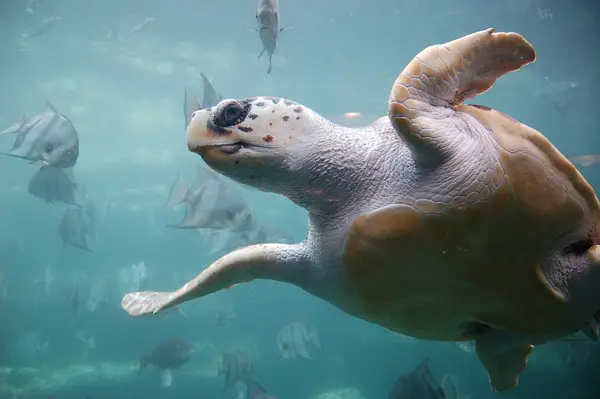
- Scientific name: Caretta caretta
- Common name: Loggerhead, Loggerhead Sea-Turtle
- Family: Cheloniidae
- Size: 3.5 feet
- Lifespan: 70+ years
- Conservation status: Endangered
Loggerhead sea turtles boast their place as the most abundant sea turtle species in the United States and are found in many states, including California.
These turtles are pretty big and can reach up to 3.5ft in length. They weigh up to 350 pounds and can live for a whopping 70 years or more.
A loggerhead is distinguished by a slightly heart-shaped carapace that’s reddish brown in color, with pale yellow plastron. Some species also feature yellow-bordered scutes.
This turtle species of California gets its name from its large head. It has powerful jaws that enable it to feed on a variety of foods including conch, whelks, insects, jellyfish, gastropods, and algae.
The loggerhead turtles in California are usually found in temperate, tropical, and subtropical waters all year round.
6. Green Sea Turtle
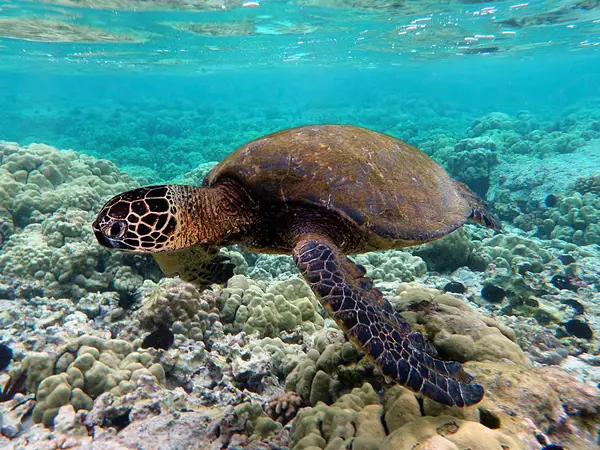
- Scientific name: Chelonia mydas
- Common name: Green turtle, Pacific green turtle, Black sea turtle
- Family: Cheloniidae
- Size: 2 to 5 feet
- Lifespan: 60 to 70 years
- Conservation status: Endangered
The green sea turtle species is classified among the largest hard-shelled sea turtles in California. It can reach up to 4 feet in length and weighs up to 400lbs.
This species is characterized by scutes that run down the middle; they’re 4 on each side. The shell color can be gray, dark brown, or olive with a yellow-to-white bottom shell or plastron.
It also features a serrated beak on its lower jaw and two large scales resign between the eyes.
Males are generally larger than females and have longer tails. The females lay their eggs on the beach and use their paddle-shaped flippers to easily burrow in the sand when laying eggs. A single green turtle can lay up to 200 eggs!
This California sea turtle species gets its name from its primary diet which consists of age and seagrasses (mind you, this diet is responsible for tinting its cartilage green).
Green turtles in California are usually found in tropical as well as subtropical waters throughout the years. They also tend to migrate to cooler temperatures and even boreal waters when the weather gets warmer.
7. Leatherback Sea Turtle
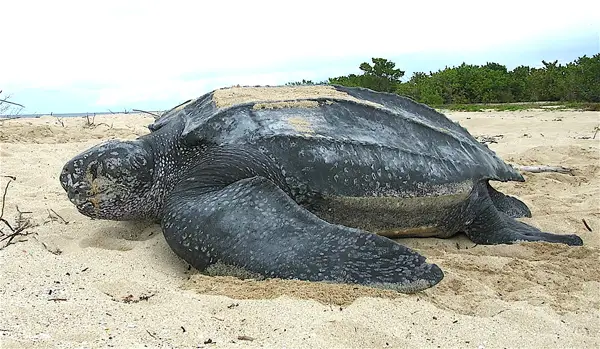
- Scientific name: Dermochelys coriacea
- Common name: leathery turtle, trunk turtle, Lute turtle, luth
- Family: Dermochelyidae
- Size: 5 to 6 feet
- Lifespan: 50+ years
- Conservation status: Vulnerable
The leatherback sea turtles are found in California state and are known to grow to mammoth sizes (up to 6 feet!). An average adult can also weigh as heavy as 540lbs!
Leatherback turtles usually have black shells. And they differ from other species of turtles with their smooth leathery carapace and skin. Their upper shell is made up of a flexible layer of dermal bones covered by tough and oily connective tissue and smooth skin.
The body of this turtle is barrel-shaped and then tapered to the rear. They have a total of 7 longitudinal dorsal ridges and their whole body is almost completely black, with some variable spotting.
Leatherback turtles in California have tooth-like cusps that work closely with their sharp-edged jaws to enable them to easily feed on jellyfish, salps, and other gelatinous zooplankton.
As for the habitat, these turtles of California are fond of tropical and subtropical waters all year round. But they tend to migrate to cooler, temperate, and boreal waters during warm weather.
Note that this species is highly migratory and can swim as many as 10,000 miles in a year between foraging and nesting grounds. They’re also excellent divers—with the deepest diving record standing at whopping 4,000 feet!
8. Olive Ridley Sea Turtle
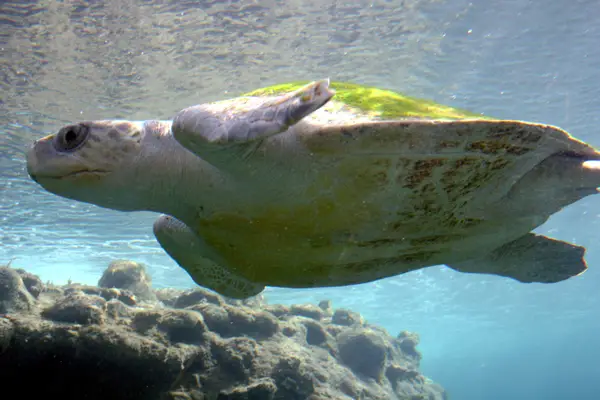
- Scientific name: Lepidochelys olivacea
- Common name: Pacific ridley sea turtle
- Family: Cheloniidae
- Size: 2.5 feet
- Lifespan: 50 years
- Conservation status: Vulnerable
Olive ridley sea turtles are much smaller than other species of sea turtles. They reach a maximum of 2.5 feet in length and weigh up to 100 pounds. And they have an average lifespan of up to 50 years.
An olive ridley sea turtle has a heart-shaped carapace with olive to grayish-green in color. The shell features around 5 to 9 scutes. These turtles are generally omnivorous and feed on crustaceans, fish, jellyfish, mollusks, algae, and salps.
These California sea turtles can opt to nest in large groups or by themselves. In the event of a mass nesting, the female turtles usually gather in large groups offshore on the nesting beaches.
This is then followed by a vast number of turtles moving ashore to nest (this event is usually referred to as arribada, a Spanish word for arrival).
The arribada is marked by numerous (hundreds of thousands) pregnant females coming ashore to lay eggs. Due to the high density of nesting experienced at the nesting beaches, the females end up digging up clutches of eggs laid by other females as they try to find a place for their eggs.
Olive ridley turtles in California are usually found in tropical and subtropical waters all year round. Though they tend to migrate to boreal waters when the climate gets warmer.
9. Sonoran Desert Tortoise
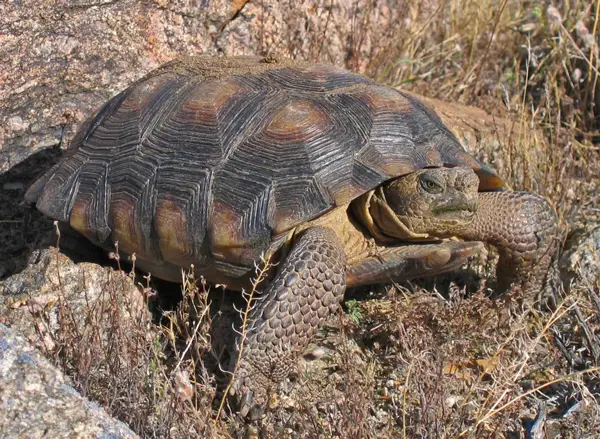
- Scientific name: Gopherus morafkai
- Common name: Sonoran Desert tortoise
- Family: Testudinidae
- Size: 6 to 14 inches
- Lifespan: 60 years
- Conservation status: Vulnerable
The desert tortoise also lives in California and is capable of withstanding little rain and intense heat. It prefers firm grounds where it can build burrows and use the rocks as shelter. A typical burrow for this desert tortoise has a unique half-moon-shaped opening.
This California desert tortoise has been observed to spend most of its life underground and only comes out to the surface during foraging or breeding. This helps its conserve water and energy.
The terrestrial tortoise is herbivorous and eats stems, leaves, and flowers.
One great capability of this tortoise is that it can withstand ground temperatures up to 140 degrees Fahrenheit—making it one of the few species capable of withstanding extreme heat and lack of rain!
The desert species of California is labeled as an “indicator species.” This means it is used to show the health of the ecosystem by observing its population health.
Unfortunately, the Desert tortoise population is on a downward trend throughout its habitat. This has been attributed to various issues including mining, expansion, natural predation, and destruction of their burrows by off-road vehicles.
Related: Turtles in Utah
Conclusion
These are the 9 different types of turtle species inhabiting the golden state of California. The state is home to both native and non-native species. The latter group is caused by pet releases by pet owners into the wild.
California waters boast various sea turtle species including leatherback, loggerhead, green sea, and Olive Ridley sea turtles. The state is also home to box turtles.
We hope that the information shared in this guide has helped you understand the different turtle species of California and the unique traits of each of them.
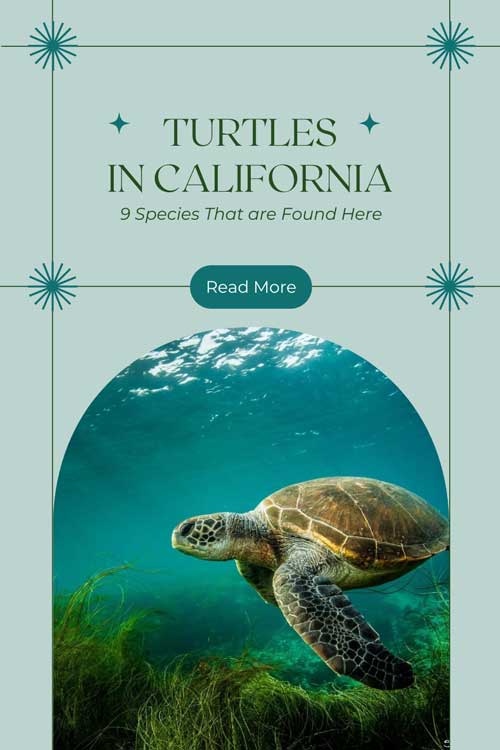

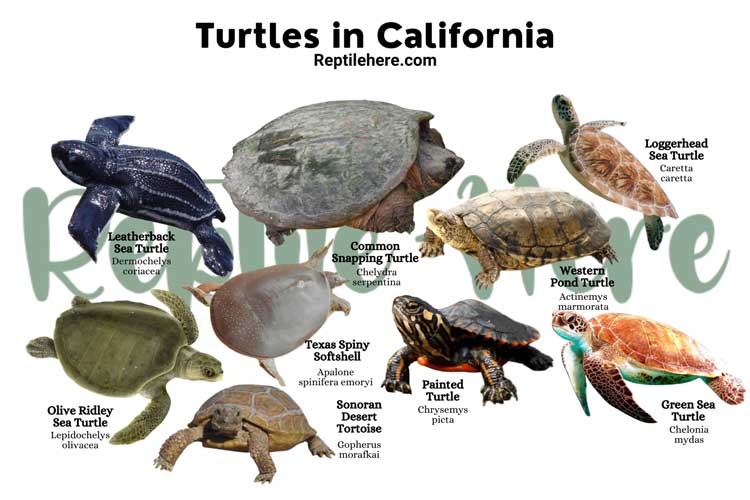
You forgot the most common turtle in Calif which is the introduced red-eared slider